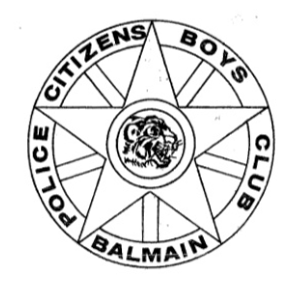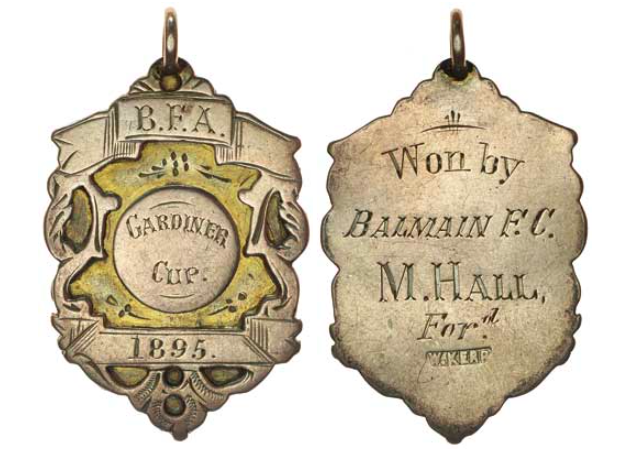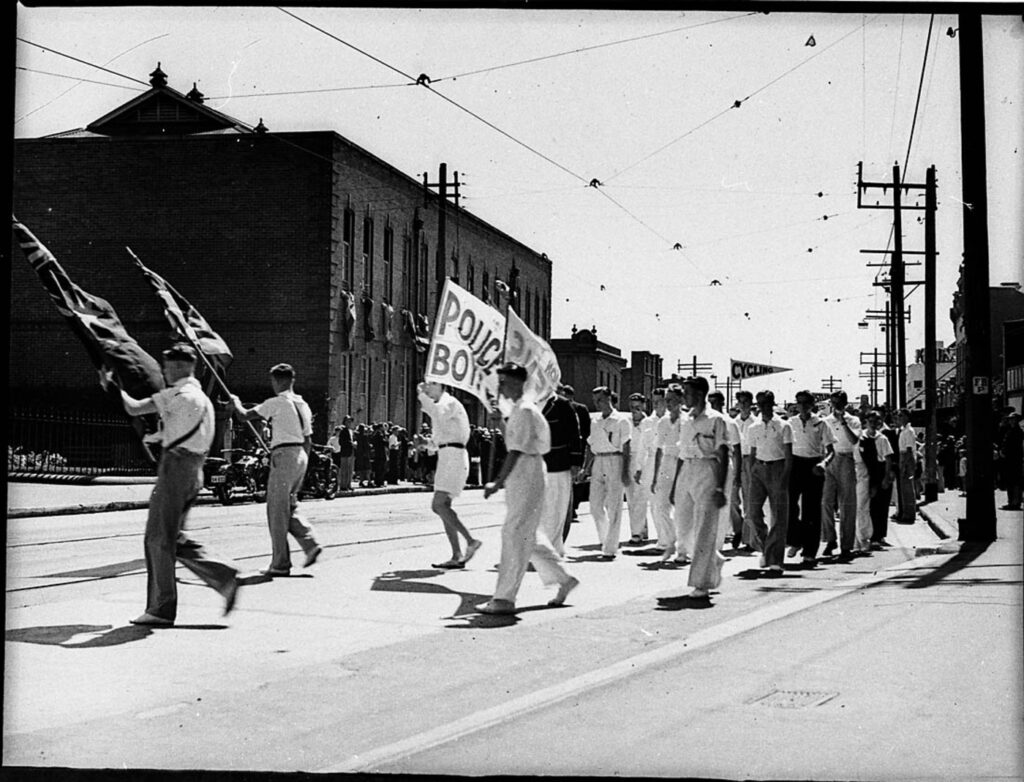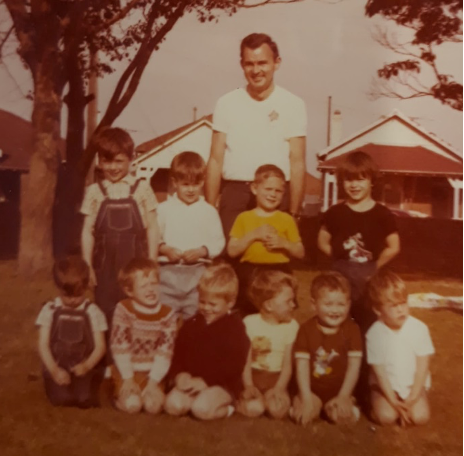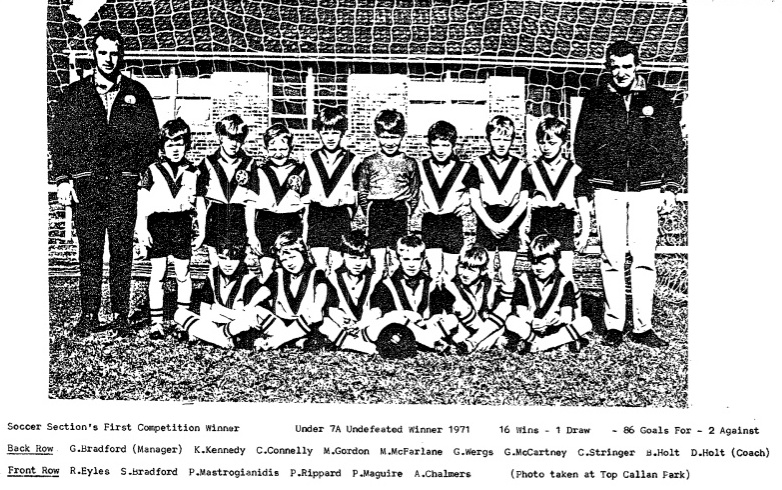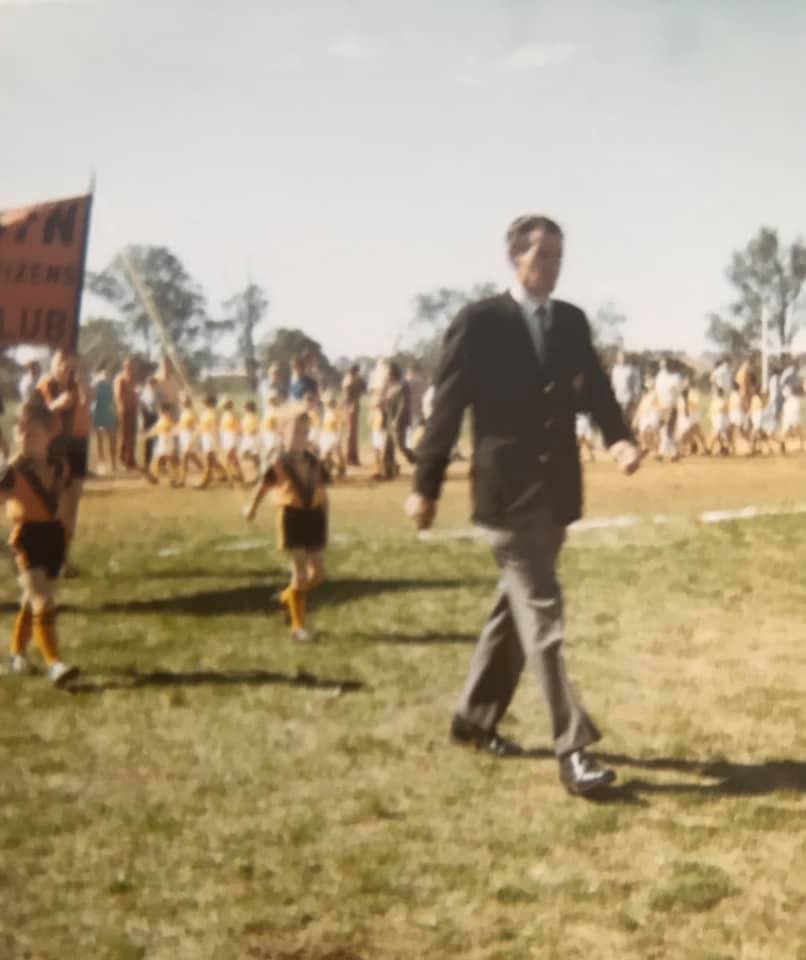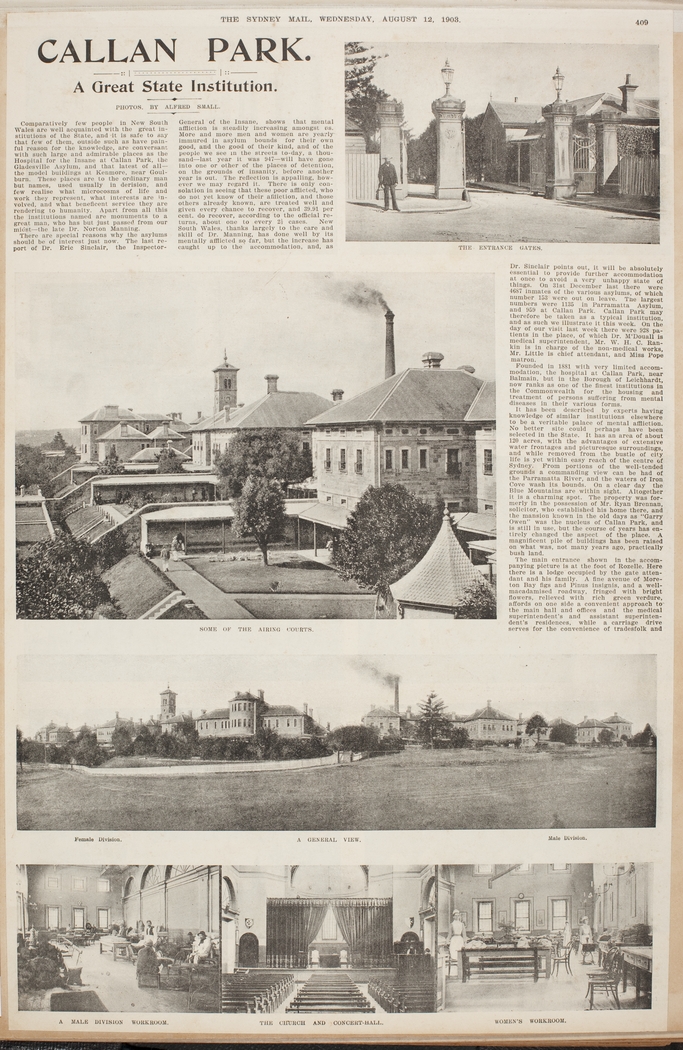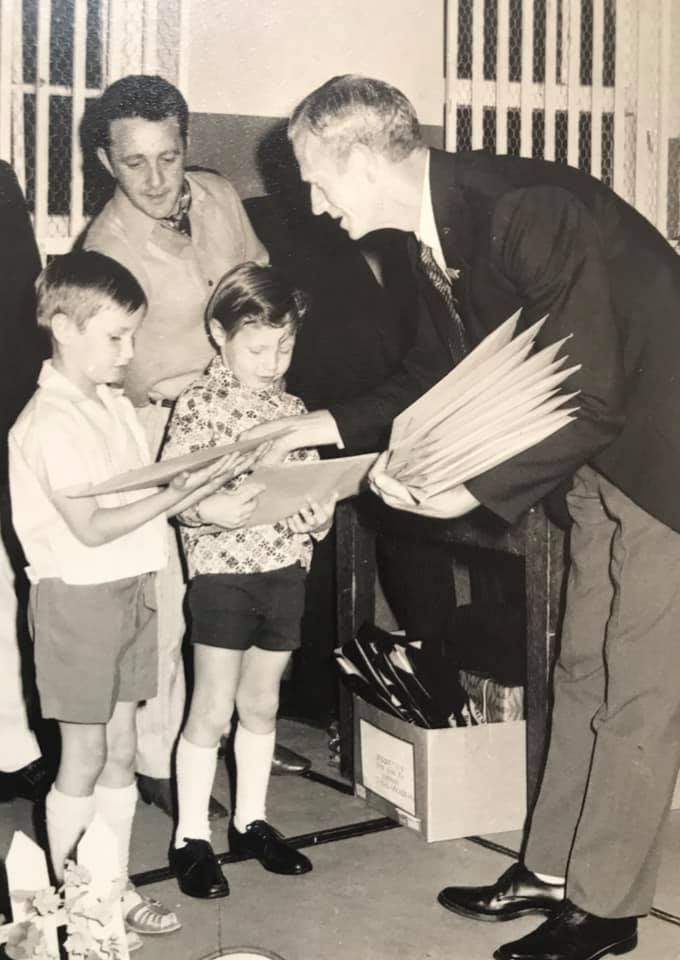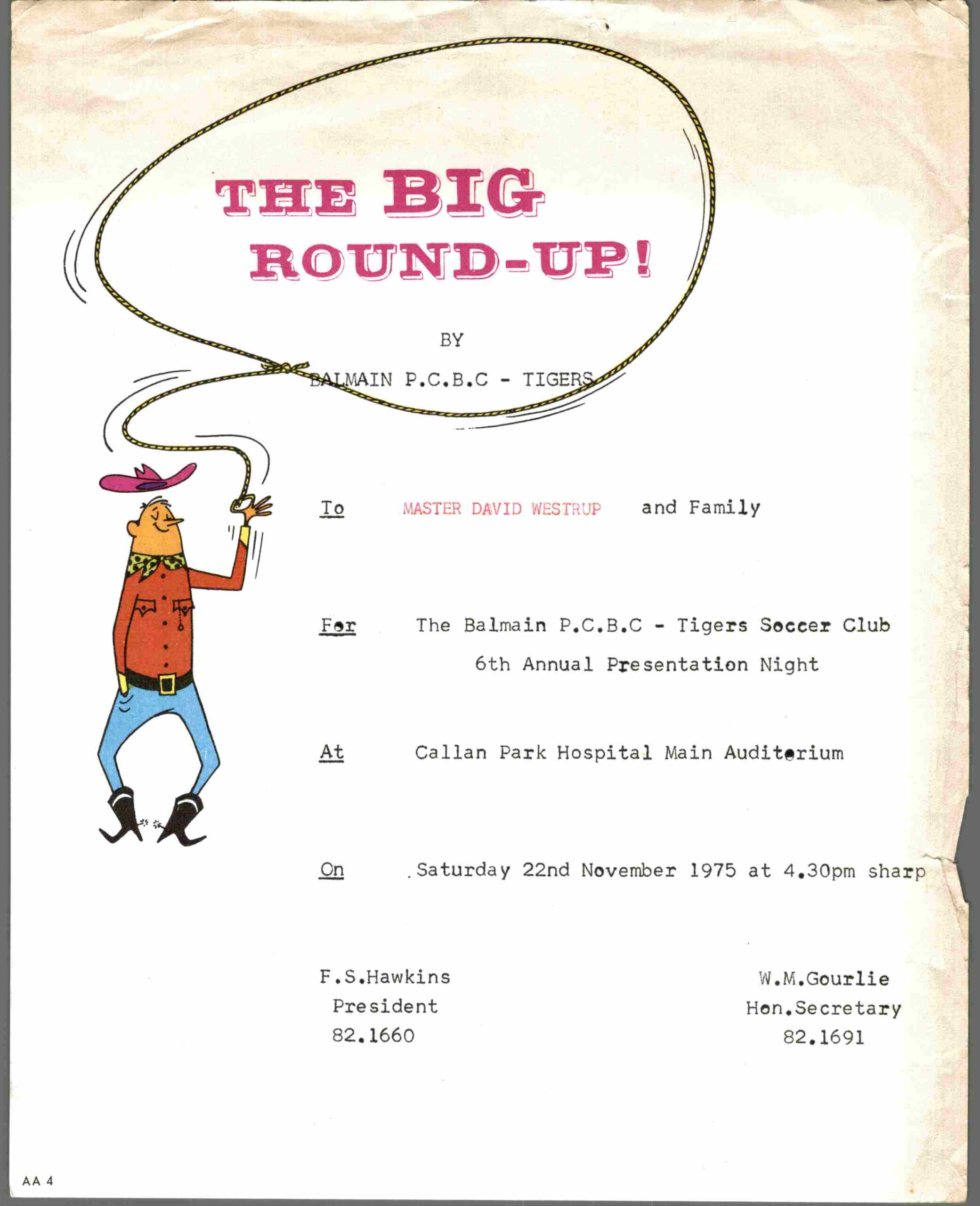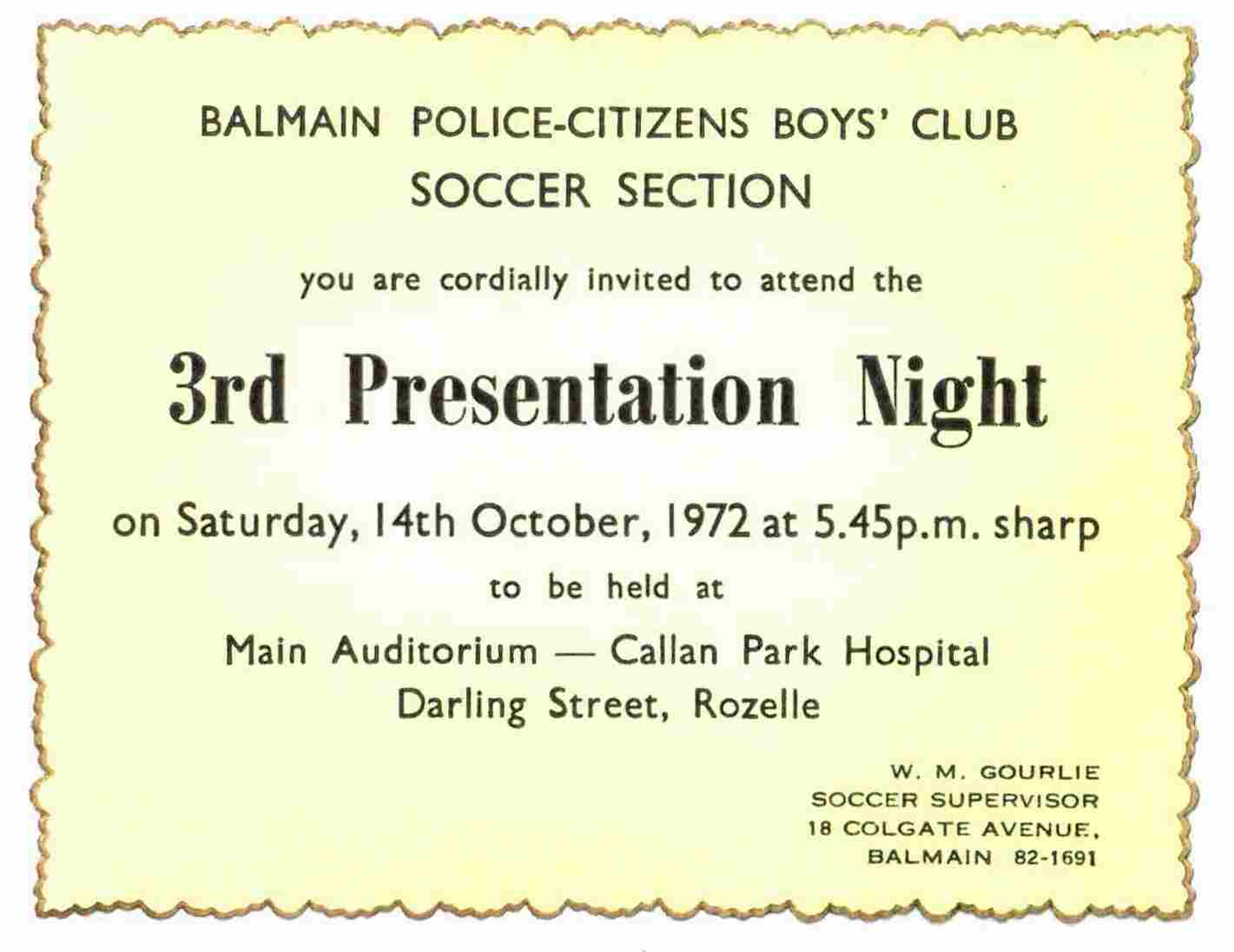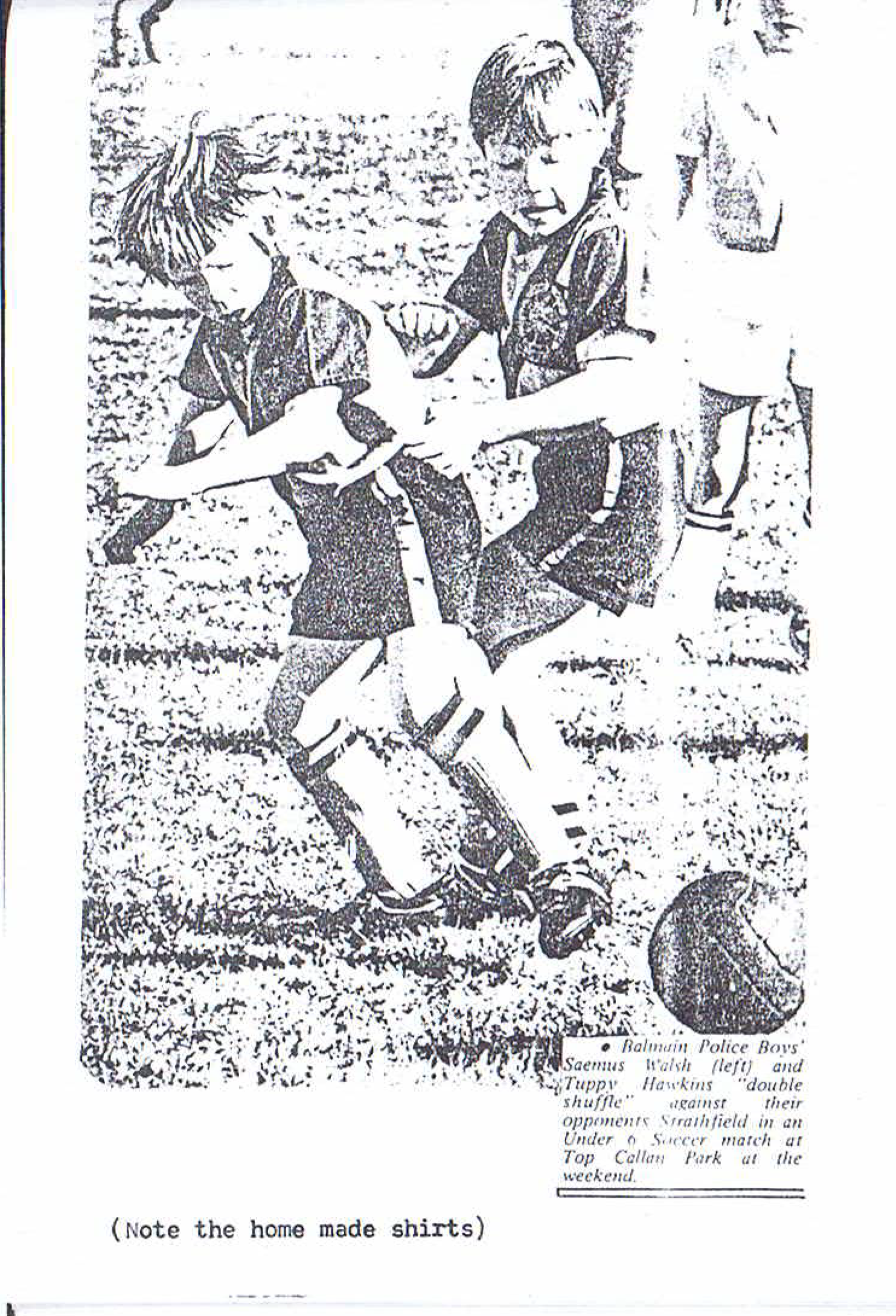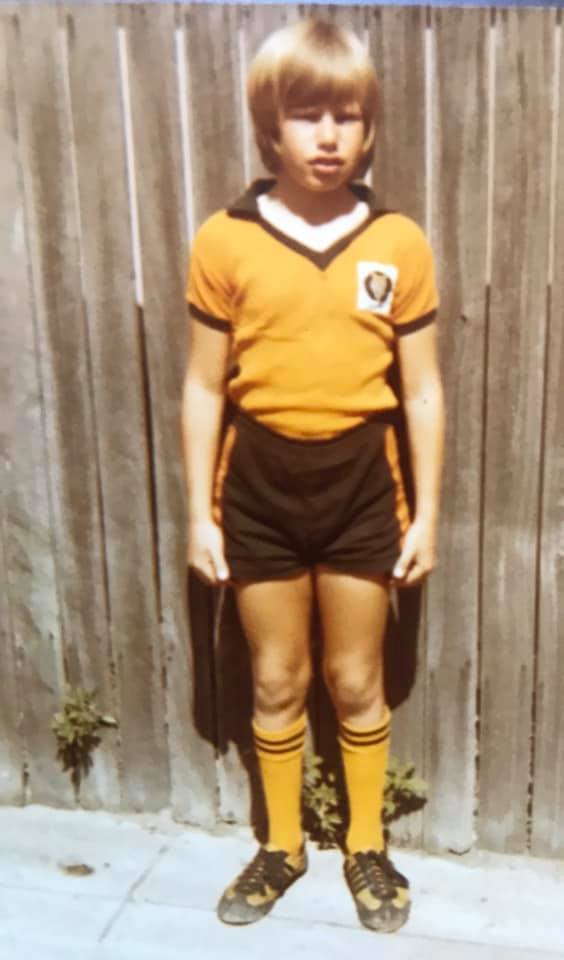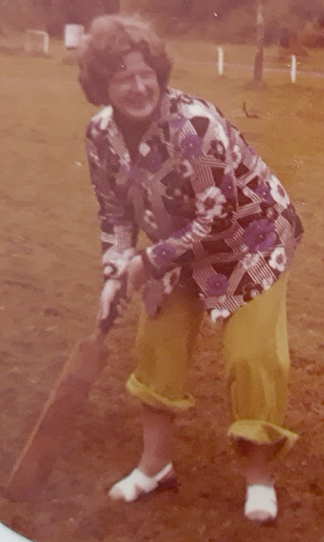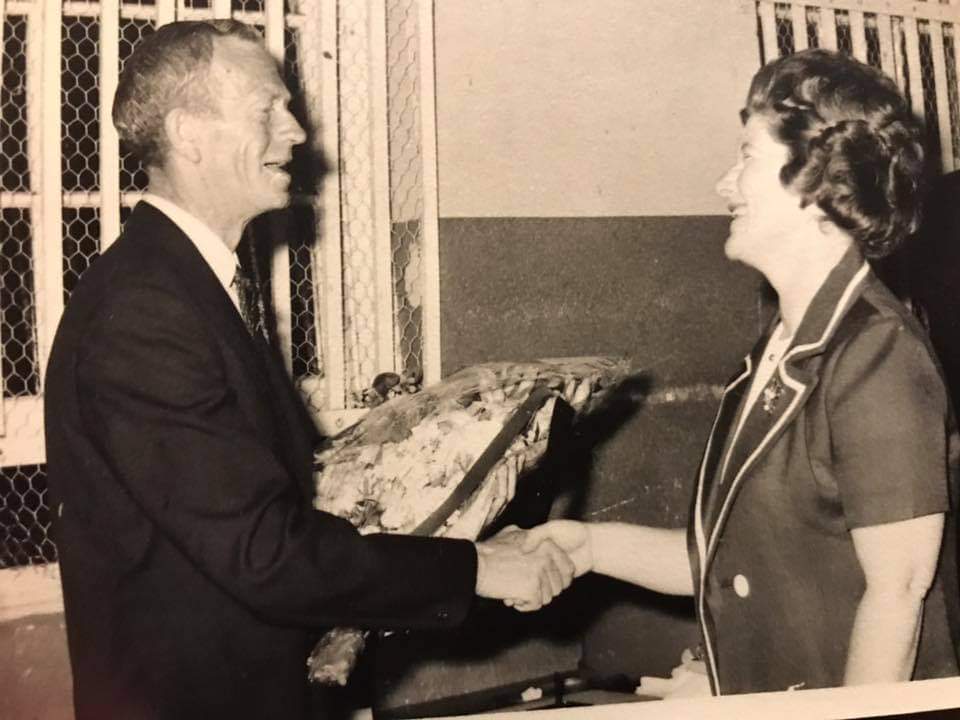The Early Years
1969 – 1979
Club Formation
The Balmain & District Football Club (BDFC) as we know it today looks very different from when it first came into being. As lifetime member Craig Hawkins remembers, it began because his father, the ex-navy man Frank Hawkins and good friend Wal Gourlie ‘had the sh*ts with the Balmain RSL soccer club’. One fine day in the late sixties, they decided to walk down to the Balmain Police Citizens Boys Club (BPCBC), which was only a mile down the road from the RSL, and have a chat with Sergeant George B. Stone, who ran the BPCBC at the time. They wanted to see if they could get another club going under the organisation’s banner. Remembers Craig:
They basically walked in and sat down with Sergeant George Stone and said ‘this is what we want to do’. Sergeant Stone did everything that needed doing and supported them like crazy.
In 1968 the trio began scouting for talent, and in 1969 a formal proposal was put forward to set up a “soccer section” of the club. Management gave it immediate approval, and in doing so, would end up fundamentally changing the sporting community in Balmain forever.
Frank Hawkins, Wal Gourlie and Sergeant George B. Stone were now the Foundation Members of our beloved club. While they were right in thinking there was an interest in the sport, ‘the only players we were sure of the time were my own two boys,’ F. Hawkins admitted some 20 years on. In fact, the first teams were created wholly around the ages of his sons and their friends. Says C. Hawkins:
They started with three teams – an U6, U7 and U8. That was because I was the oldest at around 7, and my brother [Brad] was at that stage five. They convinced a number of people to come over and do the coaching who were also involved in the RSL club.
Suddenly, we had three teams. Of course, the next year I was older so I went to the U9s. They had a 6, 7, 8, 9 and it just progressed like that. I think in a couple of years it went to 14 or 15 teams.
It wasn’t called Balmain DFC – it wasn’t even called football – and it wouldn’t be for another 40 years. But, launched by terrific leadership, maintained through tireless support and lifted up by a love of the beautiful game, it was our club all the same.
Still continuing today as the PCYC, the Police Citizens Boys Club (BPCBC) was a movement established in 1937 by Police Commissioner William John MacKay in partnership with the community, which aimed to provide interesting and safe activities for young people. Prior to 1970, these activities included boxing, gymnastics, table tennis, rugby (for which Balmain’s Wayne Pierce was a junior player), trampolining and weightlifting, and would expand to include a brass band, wrestling… and football. (Or soccer, as it was then known.)
Because BPCBC did, in fact, have an U14 football team in 1969. They played just one match, and were soundly defeated 30-0 by a Balmain RSL team. As recorded in the club’s 20th Anniversary Club Report:
The team’s biggest thril [sic] was when they scored a lone goal over the season.
KICK OFF
BPCBC was a vast organisation, running multiple sports codes simultaneously. While the Boys Club committee was all in for the “soccer section” in spirit, there wasn’t any cash support. ‘At the last minute, we donated the princely sum of $2.50 each so as to launch a Club with assets,’ recalled Frank Hawkins, with Wal Gourlie making the $5.
This meant that the section was 100% subsidised by players, their families and the fundraising activities (from fun runs, to Christmas fetes, to disco nights) of groups like the Ladies Auxiliary, who were mainly made up of mums and led by Frank Hawkin’s wife Joyce.
As Wal Gourlie wrote in the 20th Anniversary Club Report:
We had virtually no funds, equipment or players and having now been committed, great pressure was applied to achieve the necessary in order to field teams in the pre-season matches. We feel certain that had we not received such grand support by the families of all the boys and the privileged of using a ground at Callan Park Hospital, our efforts would have been dashed forever. Therefore, it was very pleasing to see us commence the season with three fully equipped teams, a home ground complete with our own goalposts and nets and fully knowing the full backing of the Balmain Police-Citizens Boys’ Club was there if needed.
Forty-five boys were the club’s foundation team players. In our first year as a club, they took on teams across Sydney, and participated in up to eight major competitions. The very first was the Captain Cook Bi-centenary Cup, with the Under 7 team getting a good win for their first game, but knocked out in the second round. Despite this, the club was pleased with the result, given ‘the lads had no match experience and had learned a lot’.
Later that year, the teams would also compete in the Liverpool Bi-Centenary, the Queens Birthday Gala Knock-Out, the John Woodfield Trophy, the Blacktown Hospital Cup and the Western Suburbs Pre-season Knock-Out.
The Mt. Pritchard Cup was made memorable in that it was disrupted by a ‘sudden outbreak of sickness’ amongst the U6 and U7 boys, forcing the club to withdraw.
Health and spirits returned for the 1970 Competition Proper, in which the “Tigers” put on a sterling performance, with two undefeated runners-up and the other placing third. The results ‘speak for the happiness and contentedness of Coaches and Managers and just sheer bad luck in that one of the teams didn’t win a competition’, wrote Frank Hawkins. He continued:
The lads that made up the respective teams and the coaches and managers who steered them over the rough spots are to be highly commended for always turning their best efforts and for upholding the good name of “Tigers”, no matter where they were, bit Kogarah, or Blacktown or St. Mary’s.
Hawkins was the first Club President, and Wal Gourlie the first club secretary. By 1974, the club had grown to 12 teams and 162 players, ranging from five years to 15. As the club expanded, so too did its successes. 1973 in particular was the year of the “Tigers”, with 20 players chosen for representative football, and the club breaking a record by winning the John Woodfield Trophy three years in a row.
The triumphs were not wholly consistent this decade however; the 1975 report begins: ‘This was not a good year.’
Playing in three different Associations took its toll…Clubs fielding two teams in an age group had little chance with their second team, outclassed and outplayed.
The following years, the club attempted to remedy the “disasters” of 1975, and by ’78 had secured no less than four Premierships.
According to football legend “Captain Socceroo” Johnny Warren in his “Shooting For the Stars” column published around that time, the club played 77 games over three years and won the lot of them with 395 goals and 5 concessions. ‘A record we would all like to emulate,’ wrote Johnny.
Ten years after it had been created, the club had achieved the ‘pipe dream’ of its founders. ‘Well, we made it,’ wrote Wal Gourlie in his final report as Club Secretary in 1979. ‘Hard work, skimping and saving paid off, we can honestly boast we are the biggest junior club in the Protestant Churches Soccer Football Association and also the biggest in the Municipality.’ On the strength of players, they went ‘soccer mad’ Gourlie joked, reaching 19 teams and 250 players in 1979, all under 15 years, with 34 Managers and Coaches.
Craig Westrup and John Martin were some of our earliest referees in 1979. ‘A job that nobody wants to do, but every one wants to tell you how to do it,’ quipped Secretary Gourlie. ‘Congratulations to you both for trying to keep so many happy and sad.’
Finding willing and skilled referees would prove an ongoing problem for the sport. Often times, teams would turn up to a field and find themselves without a referee to call the play. Frank Hawkins arranged for a referee course to be done at the club for anyone – child, teenager or young parent – who wanted to do it.
Frank encouraged his own son Craig to become a referee too. But there was one problem… Some fifty years on, Craig confessed:
To get me into the course, I had to lie about it and tell everyone I was 12. I held a full international referee certificate at the age of 10! I’m the youngest person the world to hold one – but because they had to lie about my age, you won’t find it anywhere.
THE FIRST HOME GROUND
The field at Callan Park Hospital – known as “Callan 2” – was the first home ground for the club, just across the road from the old bread factory. Frank Hawkins had worked at the psychiatric hospital since leaving the navy in about ’65 – first as a registered nurse, then as the head of Broughton Hall, which was one of the smaller facilities within the hospital complex. He very persuasive in using his work connections to find a nearby spot for the fledgling club.
Dad approached his bosses and said ‘Hey, we need a soccer field for a football club. I notice there’s a patch of grass over there that would be just about the right size for a football field…’
– Craig Hawkins, Frank’s son
The management at the time were accommodating to his pitch, and their early support was critical to the club’s successful launch. Mr H. Smaith, the senior gardener of the time, also received the club’s sincere gratitude ‘for the care and preparation of what has often been referred to as the “Best Ground for junior soccer anywhere in the Western and Northern Suburbs District”.’
There were still a lot of hands-on work that needed to be done by the players and their parents. Craig Hawkins, one of the first players, remembers this well.
The soccer posts weren’t left up all week, so we had to build them up every Saturday morning and take them down after the last game. I can remember laying out the pitch and laying out the field. Mr Westrup was there, Mr Holt was there, Mr Chembrey was there. They dug the holes for the post, and then Mr Holt, who was the referee said: ‘Sorry to tell you guys, but you’ve dug the holes at the wrong spot! You’ve put them on the wrong side of the line!’ So we had to redig the holes. After every game, four or five kids would be instructed to carry the posts around. There was an old garage behind one of the houses at the top end. We used to march the posts around literally on the shoulders of three of four kids, then a few adults would slide them up onto the roof. Then it would happen the other way around the next week.
Of course, the field was too small to contain growing boys. ‘We grew too big for Callan 2, because the boys were getting older and the balls were starting to land in the front yards of the houses and people were getting the sh*ts,’ says Craig. ‘By this stage, dad was hobnobbing with the bosses of the hospital. His office was down the bottom of the road. He walked down west and he decided it would be a really good place for the soccer field. I don’t know how it happened, but somehow he got permission.’
Frank’s doggedness and hard work were widely recognised by all. ‘I’ve always said,’ wrote Wal Gourlie in 1979, ‘the grounds should be known as Frank Hawkins 3 and 4.’
In later years, football games were also moved down to King George Park in Rozelle. By the mid to late 1970s under the dogged efforts of Frank, the club also gained used of Callan Park 3 and 4, and occasionally, Timbrell Park in Five Dock for the younger players. Callan 3 opened just in time for the start of the season, with volunteers pitching in to help with planting grass and top soiling.
Craig Hawkins remembers his dad’s wily, out-of-the-box and madcap genius solutions to soccer field problems.
Every time it rained [on our new field], there’s a swamp. So dad then decides somehow the way to fix it is with coffee grounds. Dad goes to Bushells Coffee, which had a big factory at Burwood at the time. He says to them: ‘Hey guys, do you want somewhere to dump your waste coffee grounds for free? I’m building a soccer field, I would like coffee grounds for fill and drainage and such.’
Within a period time, there are hundreds and hundreds of trucks, trundling their way across from Burwood to the soccer grounds. It was literally about two meters of coffee spread across that field. He’s then talked the whole parent group to come in and level the grounds and plant the grass and do the whole thing.
Every weekend there was a working bee of gentlemen, but plenty of ladies too. I remember Maureen Kennedy turned up, and the workers said ‘What are you doing here?’ ‘I’m here to help, shut up and give me a shovel,’ she said.
They built this soccer field on literally a couple of meters of excess coffee grounds. It played like a billiard table. It was always covered with this beautiful grass. When you fell over on the ground, you never got wet, and went home smelling like Nescafe!
People who have got no connection with the soccer ground or the sport district at all, know it as the Coffee Fields, but nobody ever knows why. Which is very cool.
By the time the club had got to Callan 3, ‘someone, somehow’ had ended up with a caravan, which the Ladies Auxiliary ran their tuckshop out of. They sold all kinds of things out of that caravan, says Craig Hawkins – including apples from Orange.
Dad had a friend up in Orange who had an orchard. He used to go up there for work to bring psych patients pack to the hospital. They used to drive up in the morning and back that evening and he’d stop at Dale’s orchard and bring back hundreds and hundreds of apples to sell at the tuckshop so all the kids all got fresh apples. Stuff that no one else would think of became the fabric of the club.
PRESENTATION NIGHT
At the end of each season, and all thanks to the fundraising efforts of the club’s women, every child received a trophy, and every team that won their competition got club jackets. The club’s first presentation night was held on 7 November 1970 at the Balmain Police Citizens Boys Club, at 372 Darling Street, Balmain (which is still the address of the PCYC). Photos of this auspicious event appeared later in the local newspaper – most likely Balmain News. The night was:
…a combination of a year of solid work, worry and soccer and giving us a feeling of wonderful satisfaction on seeing the delighted looks on the faces of three small squads of “Tigers”. It was a thrilling occasion and a fitting end of a wonderful season.”
– 1970 Report
The presence of the BPCBC Brass Band and Drum Corp – in full uniform no less – added extra pomp and good cheer to the proceedings. Following the presentations, all were seated before a magnificent party spread prepared by some tireless club supporters. ‘It was most gratifying to see not much left afterwards,’ wrote Wal Gourlie, ‘a child’s approval of a “good night”.’ Craig Hawkins, then seven years old, agrees: ‘There were as many hot dogs and red cordial and fairy bread sandwiches that you could eat!’
In later years, Presentation Nights were held at the Callan Park auditorium, and when they outgrew this venue, moved to the nearby park.
BREAKING INTO THE BOYS CLUB
It might have been a “boys club” by name, but that didn’t stop a few girls from breaking in and getting their fair share of play. In 1977, Sarah Kew was the only girl the club had for the entire season. She played for the Under 8s team under Wal Gourlie, who also moonlighted as a coach alongside his duties as secretary.
Sarah is ‘more than just a novelty,’ wrote Gourlie. ‘Enthusiastic, argumentative and affectionate, she finally realised that when the opposition sees someone as big as her running up to tackle them, they hesitate long enough for her to gain the advantage. Having taken charge of the ball however, she still must learn to pass it to one of her own players.’
TACTICAL CLUB MANAGEMENT AND HOMESPUN HEROES
In the early days, the club was entirely self-supporting, with no club fees. The theory was no kid in Balmain should have to pay to play sport. On occasion, temporary fiscal support was sought from the BPCBC, but the advanced funds were always returned. A Boys Club Fete helped the club raise funds from supporters.
The children (or rather their parents) did have to buy their own socks and shin-pads. They were also required to be members of the BCPBC, which cost about $2 annually. If they were members of the club, they were covered by insurance. The first Balmain strip was designed by Frank Hawkins, inspired by the jerseys of the winning NRL Tigers team, and they were all hand-sewn. In 1971, orange material was bought and the ladies of the club got to work.
The reason you had one ‘V’ instead of two around the neck is because it was too hard to sew two solid black Vs by hand onto a jersey. The first year they played, there was a hand-drawn circle with a tiger’s head painted on. Then there was a sewn-on patch. The shorts had the gold stripes sewed on by hand, too. I guess it was the way of the sixties, just labour-intensive. The whole thing was an absolute labour of love.
– Craig Hawkins
By 1978, Frank Hawkins had retired from the club with his wife, and the new President Ted Westrup admitted that it was ‘becoming very hard’ to maintain their proud policy of free football. That year, the club also got its first Honorary Registrar in Mrs Betty Powter. ‘I must admit it took me a long time to wake up why you was alongside the caravan at Callan 3, until I noticed you pouncing on the managers and coaches for the information you required,’ joked Westrup to Powter in his club report.
These being the days when not everyone owned a computer or understood email, club news was relayed through the Tiger Rag, a weekly print publication. At first managed by the Club Secretary, it was delegated to a Publicity Committee after getting a bit too much for the increasingly overworked member to handle.
In the small hours of Christmas Day in 1974, Cyclone Tracy landed in Darwin. Its terrifying force would destroy 80% of the city and claim 71 lives. The impact was devastating, and news of the tragedy shook the country. In Balmain, the club recognised it had to step up in the hour of need. Craig Hawkins, only a small boy at the time, remembers it well.
Dad is one of the kingpins of the hospital by now, and has one the offices down the bottom. He wakes up on Christmas and somehow coordinates George Stone, Wal Gourlie, and I think one of the leaders of the Rugby League club to do something. They’re all at the Police Boys Club that morning.
By that afternoon, dad had arranged to reopen all the hospital wards in Callan Park that had been shut by the government years ago. He coordinated all the refugees who had come into Sydney from Darwin. They had been picked up in buses and driven and Callan Park and given clothing and stuff like that.
Wal Gourlie and George Stone pretty much organised every kid in the club and they went on door knocks. They walked the streets, they knocked on every door on the district, looking for donations, for clothes, for food, the lot.
Our club raised more money for the Darwin Cyclone than anyone other district in the country.
I was twelve years old. I was mucking out hospital wards on Christmas afternoon with my dad. The rest of the soccer club around door knocking and bringing everything do the club. We worked non-stop for six days. That’s the soccer club.
There was little Frank Hawkins wouldn’t do for the club, as his son Craig remembers. There was no problem he couldn’t solve with a bit of elbow grease and old school ingenuity.
Dad [Frank Hawkins] grew up in the bush, one of eighteen. He was a scrounger, a scavenger and a bushie. He had this idea that to raise money for the club, he’d start collecting aluminium cans. They had the aluminium can drive and of course all the cans were dumped in the back of our place at Leichhardt, which was about the size of a quarter of a penalty box.
There were millions of cans. Because the can recycling company in those days wouldn’t accept cans unless they were crushed, guess whose job it was to crush all the aluminium cans! I think it was 5c a pound from memory. There were 21 cans to a pound. But it you stuck a couple of orange peels in the can before you crushed it, you could take the weight up. He’s dead now, they won’t catch him!
When we’d had enough of that, dad decided to go to collecting glass bottles. Which meant for two years, we couldn’t play in the back yard because of the glass shards.
– Craig Hawkins
THE LADIES AUXILIARY COMMITTEE
Founded by Joyce Hawkins, wife to Foundation Member Frank, the soccer section’s Ladies Auxiliary were the background heroes of the young club. A volunteer group, these women helped the club in innumerable essential ways. The big one was fundraising, but it also included canteen management (from an unconditioned caravan, too!), assisting with club gear, preparing for the winter Soccer Carnival, and ‘all the general running around’ that comes with a growing club.
They ran a small canteen on the trees on the roadside of the ground. They sold drinks and apples and chips and all sorts of things to raise money for the club. When dad was there, the handmade uniforms, the ground fees, everything was paid for by the efforts of the Ladies Auxiliary who raised the money.
Monday nights used to be ‘ladies night’ at our place. All the ladies of the club would come down. I’m pretty sure there were plenty of cigarettes and wine consumed, but I don’t know, I was only little. They talked, they’d plan the games, the schedules, who’d man the canteen who’d mark the lines out, who’d take the posts up, who’d be responsible for putting the posts down. Carpools for kids who couldn’t get there. They just did it all. I remember them sitting around every Monday night, although I’d be packed off to bed at 7. Who knows what went on after that!”
– Craig Hawkins
Their tireless work of the committee was continually acknowledged in the club reports over the years.
Wrote Wal Gourlie (Secretary) in the 1974 report:
This Committee gave so much time and done so much fundraising, which by the way involves so much work, our Club finances have never been better. Finance is just about a 100% from the ladies which meant the manning of the canteen at Callan 2, catering for the big day at Timbrell and now the 250 Club well under way. Words could not speak highly enough for this small band of workers.
…and again, five years later:
If ever time arises, help these people wherever possible and think to yourself how much time they spend in helping to give your son or daughter free football.


